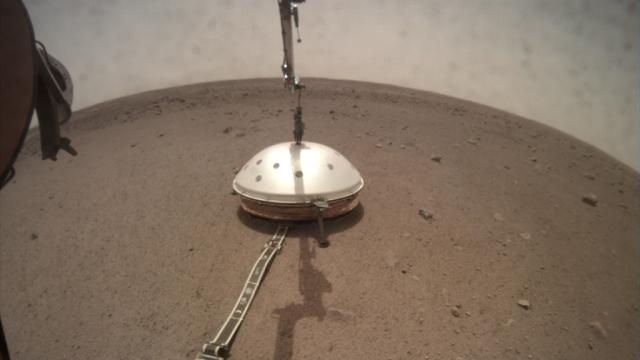A dome placed over InSight’s seismometer will now protect the sensitive device from Martian wind and extreme temperature fluctuations.
Since NASA’s stationary InSight lander made it to Mars on December 19, mission controllers have been steadily deploying its various instruments. During the past several weeks, the team has been adjusting the Seismic Experiment for Interior Structure, otherwise known as SEIS. Earlier today, the space agency issued a release highlighting the latest accomplishment in the mission—the placing of a protective dome-like covering, called the Wind and Thermal Shield, over the Marsquake detector.
[referenced url=”https://gizmodo.com.au/2019/01/good-news-from-mars-the-insight-lander-is-on-track-to-start-collecting-data-next-month/” thumb=”https://i.kinja-img.com/gawker-media/image/upload/t_ku-large/lq15hfwd1ulzyixwlqwt.png” title=”Good News From Mars: The InSight Lander Is On Track To Start Collecting Data Next Month” excerpt=”The U.S. government may be in partial shutdown mode, but operations to configure instruments critical to NASA’s InSight mission on Mars are right on schedule—and things are going swimmingly, as the latest mission update attests.”]
On Earth, seismometers are buried about four feet underground to protect them from the elements. The InSight probe isn’t capable of digging a sufficiently large hole, but it does have a robot arm, which it used to placed the protective covering over SEIS. The shield will now guard against external interference that could get in the way of accurate data collection, such as wildly fluctuating temperatures and high winds. The dome is designed such that even a strong gust won’t be able to topple the structure.
But while winds are a definite concern, it’s the wild fluctuations in temperature that pose the greatest threat to SEIS. From night to day, temperatures on Mars can swing 94 degrees Celsius.
“Temperature is one of our biggest bugaboos,” noted InSight principal investigator Bruce Banerdt in the news release. “Think of the shield as putting a cosy over your food on a table. It keeps SEIS from warming up too much during the day or cooling off too much at night. In general, we want to keep the temperature as steady as possible.”
To supplement the shield, SEIS is equipped with instruments capable of withstanding the temperature swings. Its internal components have tolerances that allow the device to function after its parts have contracted or expanded, and the instrument itself is stored within a vacuum-sealed titanium sphere for even further insulation. But as NASA explains, there’s even more protection for SEIS:
The sphere is enclosed within yet another insulating container — a copper-coloured hexagonal box visible during SEIS’s deployment. The walls of this box are honeycombed with cells that trap air and keep it from moving. Mars provides an excellent gas for this insulation: Its thin atmosphere is primarily composed of carbon dioxide, which at low pressure is especially slow to conduct heat.
With this latest achievement, NASA is getting closer to the deployment finish line, and the start of actual data gathering and the detection of seismic activity beneath the Martian surface. With this stage now over, the InSight team is preparing to deploy its heat probe—the Heat Flow and Physical Properties Package. This could happen as early as next week.
So far, this remarkable mission has gone off without a hitch. Fingers are crossed it stays that way.
[NASA]
